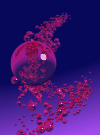VERA - Very Efficient Raytracing Algorithm
 VERA can produce realistic and non-realistic images. The algorithm gets its efficiency from a preprocessing step (using a regular grid method) in connection with a subscene technique. Besides the usual features of a raytracer it can be used for rendering copper plates and SIRDS.
VERA can produce realistic and non-realistic images. The algorithm gets its efficiency from a preprocessing step (using a regular grid method) in connection with a subscene technique. Besides the usual features of a raytracer it can be used for rendering copper plates and SIRDS.
VERA was developed at Univ- Karlsruhe, Institut für Betriebs- und Dialogsysteme. The first implementation was done by Prof.Dr. A.Schmitt in 1984; further development by Prof.Dr. H.Müller. Integration from different versions by Markus Linsenmann in 1986 to the Vera-I raytracer. After 1989 two branches were developed with focus on different topics: Vera-II and Vera-IV.
Vera-II is maintained by Univ. Karlsruhe, Institut für Betriebs- und Dialogsysteme, Abt. Graphische DV. Vera-II has a general texture mapping feature. Several projects at IBD, Univ. Karlsruhe have Vera-II as their predecessor: e.g. XRay, Portray.
Vera-IV is the other main line. It is maintained by W. Leister and M. Linsenmann. The current version is Vera-IV 2.12. The preprocessing step is implemented in a separate program, while the raytracer works on preprocessed pagefiles. In addition to a spacial texture mapping concept and many features from XRay (by Achim Stößer ), Vera-IV contains SIRDS- and copper plate rendering modes.
Many details of the Vera project are described in a book, published by Springer Verlag. Leister, Müller, Stößer: Fotorealistische Computeranimation (in german).
